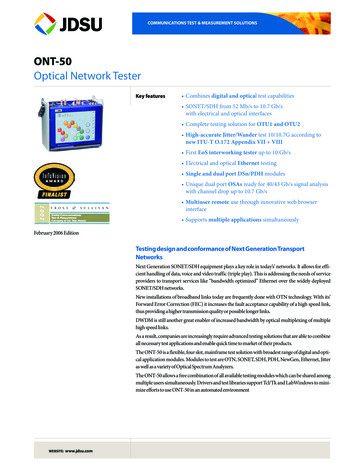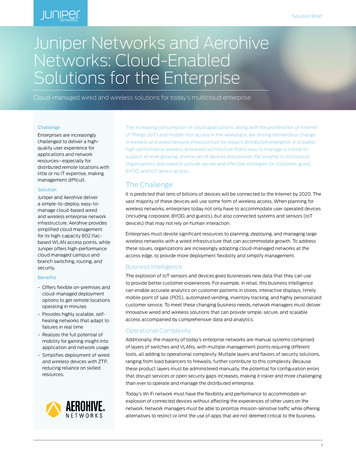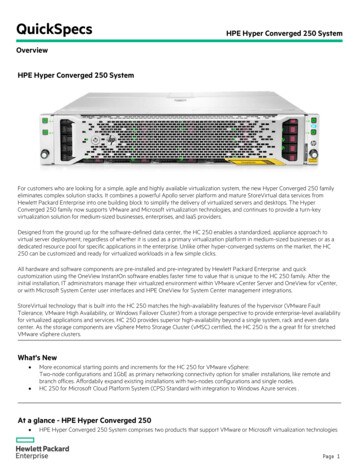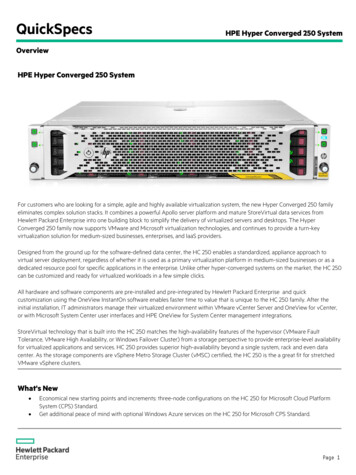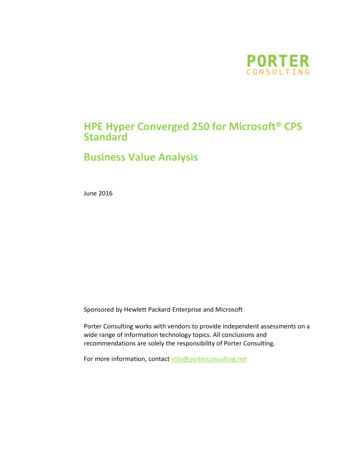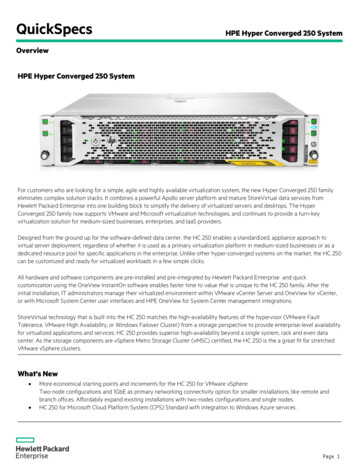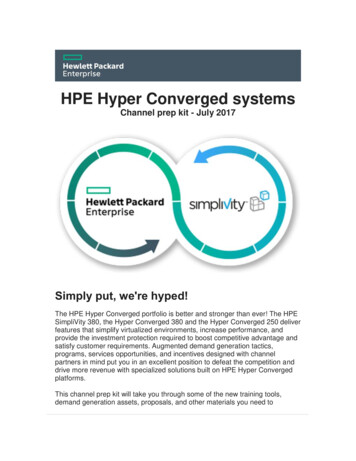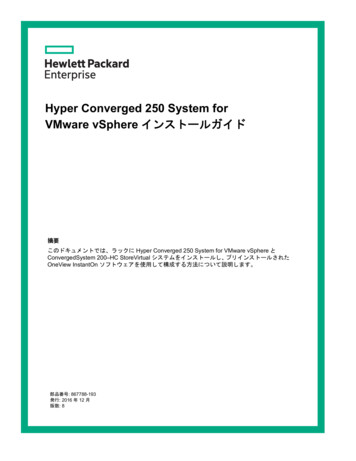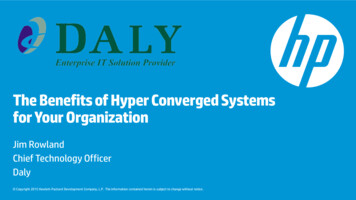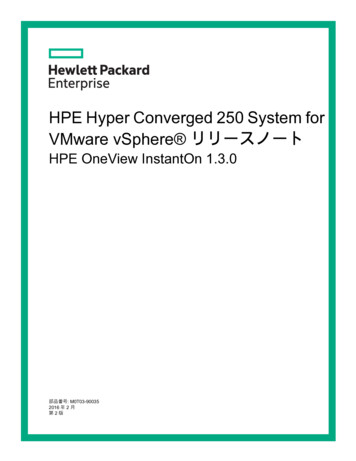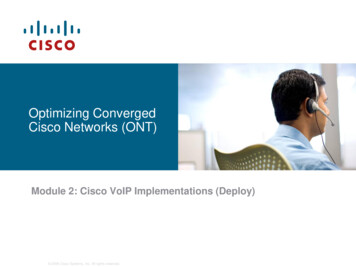
Transcription
Optimizing ConvergedCisco Networks (ONT)Module 2: Cisco VoIP Implementations (Deploy) 2006 Cisco Systems, Inc. All rights reserved.
Calculating BandwidthRequirements forVoIP 2006 Cisco Systems, Inc. All rights reserved.
Objectives Describe factors influencing encapsulation overheadand bandwidth requirements for VoIP. Explain how the packetization period impacts VoIPpacket size and rate. Explain how link encapsulation effects data-linkoverhead on a per link basis. Explain the bandwidth impact of adding a tunnelingprotocol header to voice packets. Use the bandwidth calculation process to calculatebandwidth needs for various VoIP call types. Describe how VAD is used in VoIP implementations. 2006 Cisco Systems, Inc. All rights reserved.
Factors Influencing Encapsulation Overheadand BandwidthFactorDescriptionPacket rate– Derived from packetization period (theperiod over which encoded voice bits arecollected for encapsulation)Packetization size(payload size)– Depends on packetization periodIP overhead(including UDP and RTP)– Depends on the use of cRTPData-link overhead– Depends on protocol(different per link)Tunneling overhead (ifused)– Depends on protocol (IPsec, GRE, orMPLS) 2006 Cisco Systems, Inc. All rights reserved.– Depends on codec bandwidth(bits per sample)
Bandwidth Implications of Codecs Codec bandwidth is for voiceinformation only.CodecBandwidth No packetization overhead isincluded.G.711 (PCM)64 kbpsG.726 r32 (ADPCM)32 kbpsG.726 r24 (ADPCM)24 kbpsG.726 r16 (ADPCM)16 kbpsG.728 (LDCELP)16 kbpsG.729 (CS-ACELP)8 kbps 2006 Cisco Systems, Inc. All rights reserved.
How the Packetization Period Impacts VoIPPacket Size and Rate High packetization period results in:Larger IP packet size (adding to the payload) and more delayLower packet rate (reducing the IP overhead) 2006 Cisco Systems, Inc. All rights reserved.
VoIP Packet Size and Packet Rate ExamplesCodec andPacketization PeriodG.71120 msG.71130 msG.72920 msG.72940 msCodec bandwidth(kbps)646488Packetization size(bytes)1602402040IP overhead(bytes)40404040VoIP packet size(bytes)2002806080Packet rate(pps)5033.335025 2006 Cisco Systems, Inc. All rights reserved.
Data-Link Overhead Is Different per LinkData-LinkProtocolEthernetFrameRelayMLPEthernet Trunk(802.1Q)Overhead[bytes]186622 2006 Cisco Systems, Inc. All rights reserved.
Security and Tunneling Overhead IP packets can be secured by IPsec. Additionally, IP packets or data-link frames can betunneled over a variety of protocols. Characteristics of IPsec and tunneling protocols are:The original frame or packet is encapsulated into anotherprotocol.The added headers result in larger packets and higherbandwidth requirements.The extra bandwidth can be extremely critical for voice packetsbecause of the transmission of small packets at ahigh rate. 2006 Cisco Systems, Inc. All rights reserved.
Extra Headers in Security and TunnelingProtocolsProtocolHeader Size (bytes)IPsec transport mode30–53IPsec tunnel mode50–73L2TP/GRE24MPLS4PPPoE8 2006 Cisco Systems, Inc. All rights reserved.
Example: VoIP over IPsec VPN G.729 codec (8 kbps) 20-ms packetization period (20B) No cRTP (40B) IPsec ESP with 3DES and SHA-1, tunnel mode (30 4 20) 2006 Cisco Systems, Inc. All rights reserved.
Total Bandwidth Required for a VoIP Call Total bandwidth of a VoIP call, as seen on the link, is important for:Designing the capacity of the physical linkDeploying Call Admission Control (CAC)Deploying QoS 2006 Cisco Systems, Inc. All rights reserved.
Total Bandwidth Calculation Procedure Gather required packetization information:Packetization period (default is 20 ms) or sizeCodec bandwidth Gather required information about the link:cRTP enabledType of data-link protocolIPsec or any tunneling protocols used Calculate the packetization size or period. Sum up packetization size and all headers and trailers. Calculate the packet rate. Calculate the total bandwidth. 2006 Cisco Systems, Inc. All rights reserved.
Bandwidth Calculation Example 2006 Cisco Systems, Inc. All rights reserved.
Quick Bandwidth CalculationTotal packet size—————————Total bandwidth requirement Payload ��Nominal bandwidth requirementTotal packet size All headers payloadParameterValueLayer 2 header6 to 18 bytesIP UDP RTP headers40 bytesPayload size (20-ms sample interval)20 bytes for G.729, 160 bytes for G.711Nominal bandwidth8 kbps for G.729, 64 kbps for G.711Example: G.729 with Frame Relay:Total bandwidth requirement (6 40 20 bytes) * 8 kbps—————————————20 bytes 2006 Cisco Systems, Inc. All rights reserved. 26.4 kbps
VAD (Voice Activity Detection) Detects silence (speech pauses) Suppresses transmission of ―silence patterns‖ Depends on multiple factors:Type of audio (for example, speech or Music on Hold (MoH))Level of background noiseOther factors (for example, language, character of speaker, ortype of call) Can save up to 35 percent of bandwidth (statisticaldistribution of at least 24 calls) 2006 Cisco Systems, Inc. All rights reserved.
VAD Bandwidth-Reduction ExamplesData-LinkOverheadEthernetFrame Relay Frame Relay MLPP18 bytes6 bytes6 bytes6 bytesIP overheadno cRTPcRTPno cRTPcRTP40 bytes4 bytes40 bytes2 bytesG.711G.711G.729G.72964 kbps64 kbps8 kbps8 kbps20 ms30 ms20 ms40 ms160 bytes240 bytes20 bytes40 bytesBandwidthwithout VAD87.2 kbps66.67 kbps26.4 kbps9.6 kbpsBandwidth withVAD (35%reduction)56.68 kbps43.33 kbps17.16 kbps6.24 kbpsCodecPacketization 2006 Cisco Systems, Inc. All rights reserved.
Self Check1. Describe the relationship between packetizationperiod and packet size and packet rate.2. How does the data-link protocol used effectbandwidth considerations?3. What is the default packetization period on Ciscodevices?4. What is VAD?5. How much bandwidth can be saved, on average,using VAD? 2006 Cisco Systems, Inc. All rights reserved.
Summary VoIP packet size and rate are determined by thepacketization period. Data-link overhead must be considered with calculatingbandwidth requirements. Different links have differentoverhead requirements. Adding a tunneling protocol header effects thebandwidth requirements for voice packets. Thisadditional overhead must be considered whencalculating bandwidth requirements. Voice Activity Detection (VAD) is a process used todetect silence in order to save bandwidth. VAD cansave 34% on average. 2006 Cisco Systems, Inc. All rights reserved.
Resources Voice Over IP - Per Call Bandwidth k698/technologies tech note09186a0080094ae2.shtml#topic1 Voice Codec Bandwidth decCalc1.do 2006 Cisco Systems, Inc. All rights reserved.
Implementing VoIPin an EnterpriseNetwork 2006 Cisco Systems, Inc. All rights reserved.
Objectives List the common components of an enterprise voiceimplementation. Describe Call Admission Control and how it differs fromQoS. Describe the functions of the Cisco UnifiedCallManager. Identify common enterprise IP telephony deploymentmodels. Identify basic Cisco IOS VoIP configuration commands. 2006 Cisco Systems, Inc. All rights reserved.
Enterprise Voice Implementations Components of enterprise voice networks:Gateways (PSTN connectivity) and gatekeepers (scalability)Cisco Unified CallManager (PBX-like features) and IP phones 2006 Cisco Systems, Inc. All rights reserved.
Deploying Call Admission Control (CAC) CAC artificially limits the number of concurrent voice calls. CAC prevents oversubscription of WAN resources caused by too much voice traffic. CAC is needed because QoS cannot solve the problem of voice calloversubscription:QoS gives priority only to certain packet types (RTP versus data).QoS cannot block the setup of too many voice calls.Too much voice traffic results in delayed voice packets. 2006 Cisco Systems, Inc. All rights reserved.
Example: CAC Deployment IP network (WAN) is only designed for two concurrent voice calls. If CAC is not deployed, a third call can be set up, causing poorquality for all calls. When CAC is deployed, the third call is blocked. 2006 Cisco Systems, Inc. All rights reserved.
Voice Gateway Functions on a Cisco Router Connects traditional telephony devices to VoIP Converts analog signals to digital format Encapsulates voice into IP packets Performs voice compression Provides DSP resources for conferencing andtranscoding Supports fallback scenarios for IP phones (CiscoSRST) Acts as a call agent for IP phones (Cisco UnifiedCallManager Express) Provides DTMF relay and fax and modem support 2006 Cisco Systems, Inc. All rights reserved.
Cisco Unified CallManager FunctionsCall processingDial plan administration(MGCP: Media Gateway Control Protocol )Signaling and device controlPhone feature administrationDirectory and XML servicesProgramming interface to external applications 2006 Cisco Systems, Inc. All rights reserved.Cisco IP Communicator
5501234192.169.1.1Example:Signaling5502345 192.170.2.1.and Call ProcessingRTPRTP 2006 Cisco Systems, Inc. All rights reserved.
Enterprise IP Telephony Deployment ModelsDeployment ModelSingle siteCharacteristics– Cisco Unified CallManager cluster at the single site– Local IP phones onlyMultisite with centralizedcall processing– Cisco Unified CallManager cluster only at a singlesite– Local and remote IP phonesMultisite with distributed callprocessing– Cisco Unified CallManager clusters at multiple sitesClustering over WAN– Single Cisco Unified CallManager cluster distributedover multiple sites– Local IP phones only– Usually local IP phones only– Requirement: Round-trip delay between any pair ofservers not to exceed 40 ms 2006 Cisco Systems, Inc. All rights reserved.
Single Site Cisco Unified CallManagerservers, applications, and DSPresources are located at thesame physical location. IP WAN is not used for voice. PSTN is used for all externalcalls.Note: Cisco UnifiedCallManager cluster can beconnected to various placesdepending on the topology. 2006 Cisco Systems, Inc. All rights reserved.
Multisite with Centralized Call Processing Cisco Unified CallManager servers and applications are located at the central sitewhile DSP resources are distributed. IP WAN carries data and voice (signaling for all calls, media only for intersite calls). PSTN access is provided at all sites. Call Admission Control (CAC) is used to limit the number of VoIP calls, andAutomated alternate routing (AAR) is used if WAN bandwidth is exceeded. Cisco Survivable Remote Site Telephony (SRST) is located at the remote branch.Note: Cisco Unified CallManager cluster can be connected to various places depending onthe topology. 2006 Cisco Systems, Inc. All rights reserved.
Multisite with Distributed Call Processing Cisco Unified CallManager servers, applications, and DSP resources are located ateach site. IP WAN carries data and voice for intersite calls only (signaling and media). PSTN access is provided at all sites; rerouting to PSTN is configured if IP WAN isdown. CAC is used to limit the number of VoIP calls, and AAR is used if WAN bandwidthis exceeded.Note: Cisco Unified CallManager cluster can be connected to various places, depending onthe topology. 2006 Cisco Systems, Inc. All rights reserved.
Clustering over WAN Cisco Unified CallManager servers of a single cluster are distributed among multiple sites whileapplications and DSP resources are located at each site. Intracluster communication (such as database synchronization) is performed overthe WAN. IP WAN carries data and voice for intersite calls only (signaling and media). PSTN access is provided at all sites; rerouting to PSTN is performed if IP WAN is down. CAC is used to limit the number of VoIP calls; AAR is used if WAN bandwidth is exceeded.Note: Cisco Unified CallManager cluster can be connected to various places, depending on the topology. 2006 Cisco Systems, Inc. All rights reserved.
Basic Cisco IOS VoIP Voice Commands 2006 Cisco Systems, Inc. All rights reserved.
Voice-Specific Commandsrouter(config)#dial-peer voice tag type Use the dial-peer voice command to enter the dial peer ination-pattern telephone number The destination-pattern command, entered in dial peer subconfigurationmode, defines the telephone number that applies to the dial peer. 2006 Cisco Systems, Inc. All rights reserved.
Voice-Specific Commands (Cont.)router(config-dial-peer)#port port-number The port command, entered in POTS dial peer subconfiguration mode,defines the port number that applies to the dial peer. Calls that are routedusing this dial peer are sent to the specified port.router(config-dial-peer)#session target ipv4:ip-address The session target command, entered in VoIP dial peer subconfigurationmode, defines the IP address of the target VoIP device that applies to the dialpeer. 2006 Cisco Systems, Inc. All rights reserved.
Self Check1. What is CAC?2. What can happen is CAC is not used?3. What command is used to define the telephonenumber that applies to the dial peer?4. List 4 deployment options when using the CiscoUnified CallManager. 2006 Cisco Systems, Inc. All rights reserved.
Summary Enterprise voice implementations use componentssuch as gateways, gatekeepers, Cisco UnifiedCallManager, and IP phones. Call Admission Control (CAC) extends the functionalityof QoS to ensure that an additional call is not allowedunless bandwidth is available to support it. Enterprise IP Telephony deployment models includesingle site, multisite with centralized call processing,multisite with distributed call processing, and clusteringover the WAN. 2006 Cisco Systems, Inc. All rights reserved.
Q and A 2006 Cisco Systems, Inc. All rights reserved.
Resources Video: The ABCs of VoIP (16 min.)http://tools.cisco.com/cmn/jsp/index.jsp?id 43596 Voice and Unified sw/voicesw/index.html VoIP Call Admission intwk/intsolns/voipsol/cac.htm 2006 Cisco Systems, Inc. All rights reserved.
2006 Cisco Systems, Inc. All rights reserved.
and bandwidth requirements for VoIP. Explain how the packetization period impacts VoIP packet size and rate. Explain how link encapsulation effects data-link overhead on a per link basis. Explain the bandwidth impact of adding a tunneling protocol header to voice packets. Use the
